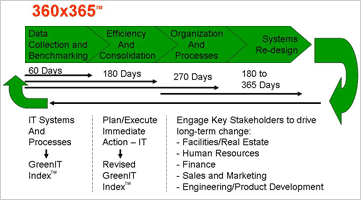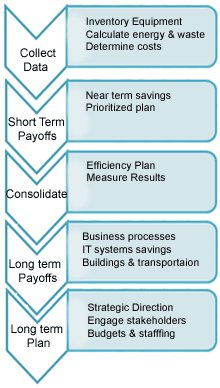GreenIT 360/365
A structured Process for Eco-Responsibility
 Any organization that has made a commitment to a GreenIT plan knows that meaningful changes cannot be accomplished without a systemic plan, multi-organizational buy-in, and staffing and funding.
Any organization that has made a commitment to a GreenIT plan knows that meaningful changes cannot be accomplished without a systemic plan, multi-organizational buy-in, and staffing and funding.
The GreenIT 360/365 Service package provides experienced staff, proven processes and custom tools to help your organization develop and execute a successful Sustainable IT program. To accommodate your situation, the 360/365 program is flexible yet provides a structured method to carry you through the process of measurement, evaluation, planning, execution and reassessment.
 Data Collection and Baselining
Data Collection and Baselining
The first step creates a detailed bottoms-up inventory of equipment, energy use, Greenhouse Gas Emissions, waste production, and costs. With this profile of IT systems and associated eco-impacts, an objective baseline is set for deciding priorities and goals, allocating resources, and measuring achievements. This step marks the preliminary GreenIT Index®.
Efficiency and Consolidations
In the next phase, GreenIT works with key participants to identify short term opportunities for improvement, create action plans and measure results. These short term programs result in immediate reductions in eco-footprint (and often costs), a medium-term action plan for further improvements, and a revised GreenIT Index® for reporting.
Organization and Process
Once near term objectives are achieved, the next step is to engage with key stakeholders (Executive Management, Facilities/Real Estate, Finance, Human Resources, Transportation, etc.) on how IT can streamline their operations. When agreement is reached on objectives , changes to budgets and operating processes are assessed.
Systems ReDesign
In the first two phases, baseline information were gathered, short-term changes were implemented, and the effectiveness of the changes were measured. In phase three, longer term initiatives for changes in business process and IT functions were evaluated and budgeted. In phase four, this information is put together into a cohesive plan for long term sustainability actions.

